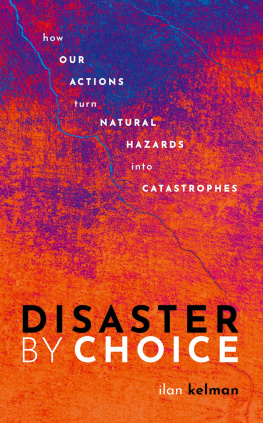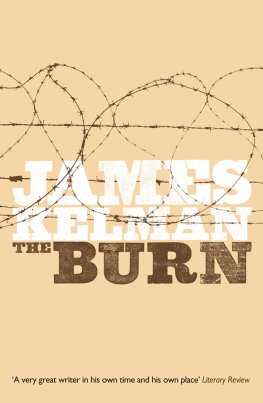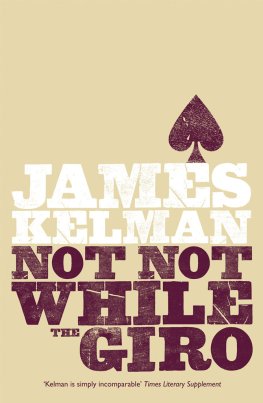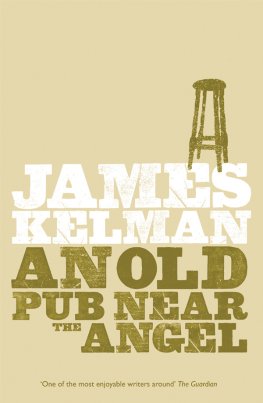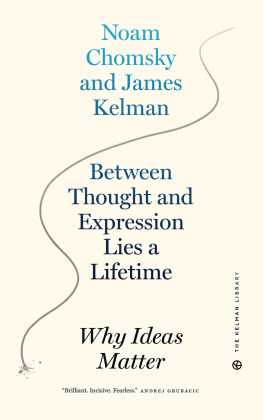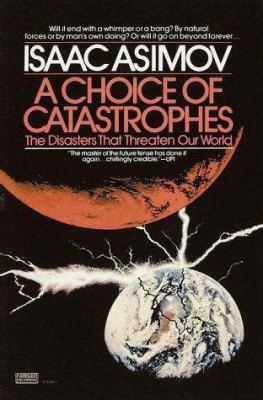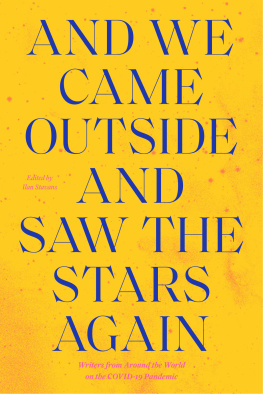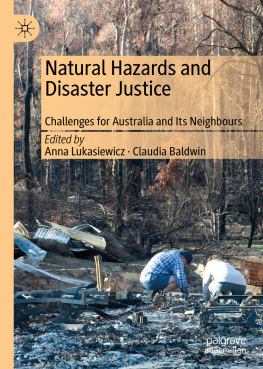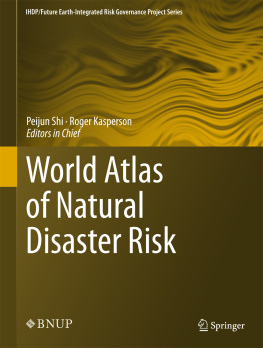Ilan Kelman - Disaster By Choice: How our actions turn natural hazards into catastrophes
Here you can read online Ilan Kelman - Disaster By Choice: How our actions turn natural hazards into catastrophes full text of the book (entire story) in english for free. Download pdf and epub, get meaning, cover and reviews about this ebook. year: 2019, publisher: OUP Oxford, genre: Politics. Description of the work, (preface) as well as reviews are available. Best literature library LitArk.com created for fans of good reading and offers a wide selection of genres:
Romance novel
Science fiction
Adventure
Detective
Science
History
Home and family
Prose
Art
Politics
Computer
Non-fiction
Religion
Business
Children
Humor
Choose a favorite category and find really read worthwhile books. Enjoy immersion in the world of imagination, feel the emotions of the characters or learn something new for yourself, make an fascinating discovery.
- Book:Disaster By Choice: How our actions turn natural hazards into catastrophes
- Author:
- Publisher:OUP Oxford
- Genre:
- Year:2019
- Rating:5 / 5
- Favourites:Add to favourites
- Your mark:
- 100
- 1
- 2
- 3
- 4
- 5
Disaster By Choice: How our actions turn natural hazards into catastrophes: summary, description and annotation
We offer to read an annotation, description, summary or preface (depends on what the author of the book "Disaster By Choice: How our actions turn natural hazards into catastrophes" wrote himself). If you haven't found the necessary information about the book — write in the comments, we will try to find it.
Ilan Kelman: author's other books
Who wrote Disaster By Choice: How our actions turn natural hazards into catastrophes? Find out the surname, the name of the author of the book and a list of all author's works by series.
Disaster By Choice: How our actions turn natural hazards into catastrophes — read online for free the complete book (whole text) full work
Below is the text of the book, divided by pages. System saving the place of the last page read, allows you to conveniently read the book "Disaster By Choice: How our actions turn natural hazards into catastrophes" online for free, without having to search again every time where you left off. Put a bookmark, and you can go to the page where you finished reading at any time.
Font size:
Interval:
Bookmark:


Great Clarendon Street, Oxford, ox2 6dp , United Kingdom
Oxford University Press is a department of the University of Oxford. It furthers the Universitys objective of excellence in research, scholarship, and education by publishing worldwide. Oxford is a registered trade mark of Oxford University Press in the UK and in certain other countries
Ilan Kelman 2020
The moral rights of the author have been asserted
First Edition published in 2020
Impression: 1
All rights reserved. No part of this publication may be reproduced, stored in a retrieval system, or transmitted, in any form or by any means, without the prior permission in writing of Oxford University Press, or as expressly permitted by law, by licence or under terms agreed with the appropriate reprographics rights organization. Enquiries concerning reproduction outside the scope of the above should be sent to the Rights Department, Oxford University Press, at the address above
You must not circulate this work in any other form and you must impose this same condition on any acquirer
Published in the United States of America by Oxford University Press
198 Madison Avenue, New York, NY 10016, United States of America
British Library Cataloguing in Publication Data
Data available
Library of Congress Control Number: 2019945429
ISBN 9780198841340
ebook ISBN 9780192578297
Printed and bound in Great Britain by Clays Ltd, Elcograf S.p.A.
Links to third party websites are provided by Oxford in good faith and for information only. Oxford disclaims any responsibility for the materials contained in any third party website referenced in this work.
To everyone who has suffered needlessly in disaster
To us all
Disasters are not natural. Wehumanity and societycreate them and we can choose to prevent them. That is the main message of this book.
Stating that natural disasters do not exist because humans cause disasters seems insanely provocative. We witness nature ravaging our lives all the time: from a city underwater after a hurricane to rows of smouldering houses after a wildfire to the dust rising from the ruins after an earthquake. How could we withstand the 400 kilometre per hour winds of a tornado, faster than Japans bullet trains, or the 1,200C temperature of lava, hotter than many potters kilns? How would we feel if an expert lectured to us that it was not natures fault, as we sifted through the few photos salvaged from the pile of debris which was once our home and our life?
Yet even when we cannot keep our infrastructure standing, we can stop people dying, we can protect our most valuable possessions, and we can learn to deal with devastation. The disaster lies not in the forces unleashed by nature, but in the deaths and injuries, the loss of irreplaceable homes and livelihoods, and the failure to support affected people, so that a short-term interruption becomes a long-term recovery nightmare.
The tornado, the earthquake, the tsunami are not to blame. They are manifestations of nature which have occurred countless times over the aeons of Earths history. The disaster consists of our inability to deal with them as part of nature. We have the knowledge, ability, technology, and resources to build houses which are not ripped apart by 400 kilometre per hour winds. If we choose to, we can create a culture with warning and safe sheltering. Lava at 1200C and a tsunami higher than our building are harder to ride out. But we can shun places likely to be hit by them or we can create a culture which understands and accepts periodic destruction, again with warning and safe evacuation, to permit swift rebuilding afterwards. The baseline is that we have options regarding where we live, how we build, and how we get ourselves ready for living with nature. Many of the choices we make currently permit death and devastation. They create the conditions for disasters.
Nature does not choose, but we do. We can choose to avoid disasters, and that means disasters are not natural.
This book was made possible by family, friends, my agent and her team, my editor/publisher and her team, and reviewers who proofread and fact-checked. Researchers, policymakers, practitioners, and many others provided the ideas and conclusions in this book long before I had started writing on this topic and they continue to inspire and direct me. They deserve all credit for the originality, innovation, and vision of this books content, while all errors are mine alone. No advice or recommendations are implied by any content in this book.

Another hot, humid, dusty day in the streets of a Caribbean capital. Flies crowd the markets and aged motorbikes and cars bounce through the potholes, coughing emissions and dodging pedestrians. Azure waves lap against the docks while street dogs and pigs scrounge for morsels in the trash heaps dotting the hill neighbourhoods. Just the typical sights, sounds, odours, and haze of life playing out as it has thousands of times before, with the shimmering heat starting to dissipate as the sun droops towards evening.
Today, though, is far from typical. It is 4.53 p.m. on Tuesday 12th January 2010 in Port-au-Prince, Haiti. Twenty-five kilometres west-south-west of the city, just thirteen kilometres below the surface, the earth jolts, fracturing rock, heaving soil, and radiating waves of motion with an intensity technically described as moment magnitude 7.0. This is high on the scale with which earthquakes are measured; just one or two earthquakes at this level or stronger occur in any month somewhere in the world, although often much deeper below the surface than Haiti experiences on this day.
The earthquakes first set of waves, the primary waves, travel twenty times faster than most passenger jets, giving premonitions of the coming destruction. Port-au-Prince has the misfortune of being so close to the ruptures centre that most people have only seconds before the secondary set of waves, the shear waves travelling half as fast, arrive. The devastation begins.
The arrondissement (district) of Logne, almost on the earthquakes epicentre, witnesses over 80 per cent of its buildings badly damaged or destroyed. Many rural areas lose the little infrastructure they have, with dirt roads cut by landslips and schools entombing pupils and staff. Around the capital, thirty kilometres away, the shaking lasts for between thirty and sixty seconds. Thousands of buildings crumble, especially the shoddily built, ramshackle dwellings inhabited by people with no choice but to live there. Some buildings collapse in on themselves or tip over. Others slide down the hills into the ravines. The stories of the people who live in these homes are rarely told: people who scrape by day to day, ambling along the unpaved roads, living without running water, electricity, or sewage systems, and then dying in the ruins of their small, dilapidated shelter.
As one lives poor, one dies poor. The immediate aftermath could not bring ambulances and fire trucks wailing through the streets, with hard-hatted rescuers ready to haul out unconscious survivors, stabilize them right there, and then whisk them away to advanced life support in hospitals. Instead, roads are impassable to cars, vans, and trucksas many were before the earthquake, with these vehicles stymied by the steep slopes, the inadequate infrastructure, and the difficulty of driving after dark. Rescue and medical services do not exist to respond, and this too is a situation long predating the earthquake. As the sun sets, the survivors wonder what to do about water, food, toilets, and sleepingquestions many of them asked every day.
Font size:
Interval:
Bookmark:
Similar books «Disaster By Choice: How our actions turn natural hazards into catastrophes»
Look at similar books to Disaster By Choice: How our actions turn natural hazards into catastrophes. We have selected literature similar in name and meaning in the hope of providing readers with more options to find new, interesting, not yet read works.
Discussion, reviews of the book Disaster By Choice: How our actions turn natural hazards into catastrophes and just readers' own opinions. Leave your comments, write what you think about the work, its meaning or the main characters. Specify what exactly you liked and what you didn't like, and why you think so.

